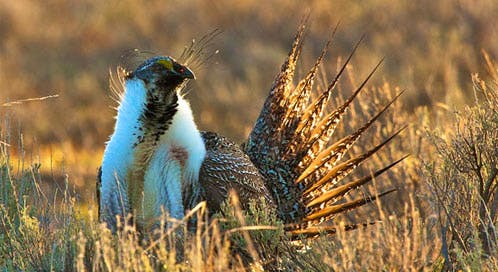Despite its immense size, the Sagebrush Sea is one of the most endangered ecosystems in North America. Half the landscape has already been lost to agriculture and urban development, and millions of more acres have been damaged by invasive weeds, unnatural fire, and harmful land uses.
The continued loss and degradation of sagebrush grasslands threatens dozens of native flora and fauna, including the charismatic greater sage-grouse. The sage-grouse is a candidate species for listing under the Endangered Species Act, and the U.S. Fish and Wildlife Service is committed to consider the bird for protection in 2015.

Burned sagebrush steppe habitat
Restoring degraded sagebrush habitat is difficult, expensive and often unsuccessful. And even where restoration works, new research led by the U.S. Geological Survey (USGS) has found that it could take decades before sage-grouse use the area again. The scientists found that burned habitat reseeded after fire in the Great Basin might require more than 20 years to regrow suitable sagebrush habitat for grouse and other species. This is bad news for an ecosystem that is prone to huge and devastating wildfires.
According to PhysOrg, “historically, the Great Basin burned in smaller, patchier conflagrations, at intervals on the order of once per century. Managers are now seeing sagebrush country burn every 20 years in parts of the Great Basin, fueled by drought and vigorous non-natives like cheatgrass.”

Healthy sagebrush steppe habitat
Federal agencies manage more than half of remaining sage-grouse habitat in the West. Prompted by the pending listing decision, the Bureau of Land Management and U.S. Forest Service have initiated an unprecedented planning process to update management plans with new conservation measures for the species. The new USGS research is important to this effort. As the authors stated, “conservation and protection of ‘what’s left’ is increasingly important [for sage-grouse conservation].”
Defenders of Wildlife has been involved in the planning process from the start, meeting with administration officials, submitting comments on the draft plans and reporting where proposed conservation measures could fail to conserve and restore sage-grouse. Throughout this process, Defenders has ardently held that federal agencies must, first and foremost, protect what’s left of the Sagebrush Sea! Management plans must exclude disturbance and degradation in the best remaining habitat for sage-grouse, and prioritize restoration in areas where restoration methods have the greatest chance for success.
We look forward to working with agencies and partners to finalize effective conservation plans to protect the Sagebrush Sea for sage-grouse and other sensitive species, and people who live, work and love the landscape.
Mark Salvo, Director of Federal Lands Conservation



